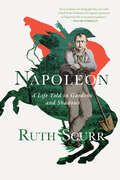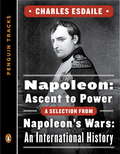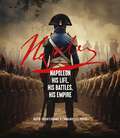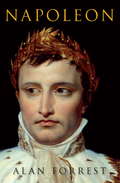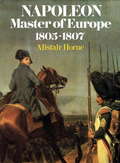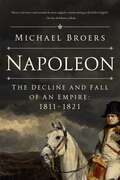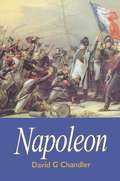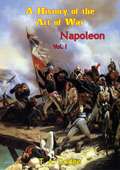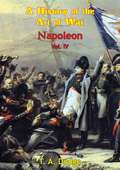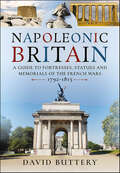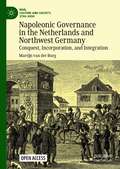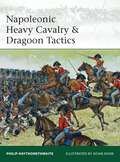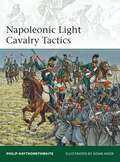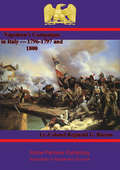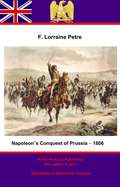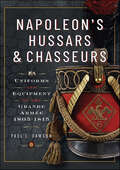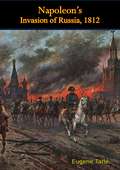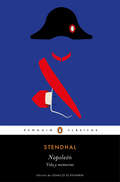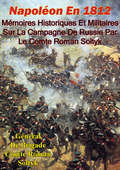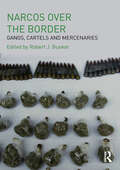- Table View
- List View
Napoleon: A Life Told In Gardens And Shadows
by Ruth ScurrMarking the 200th anniversary of his death, Napoleon is an unprecedented portrait of the emperor told through his engagement with the natural world. “How should one envisage this subject? With a great pomp of words, or with simplicity?” —Charlotte Brontë, “The Death of Napoleon” The most celebrated general in history, Napoleon Bonaparte (1769–1821) has for centuries attracted eminent male writers. Since Thomas Carlyle first christened him “our last Great Man,” regiments of biographers have marched across the same territory, weighing campaigns and conflicts, military tactics and power politics. Yet in all this time, no definitive portrait of Napoleon has endured, and a mere handful of women have written his biography—a fact that surely would have pleased him. With Napoleon, Ruth Scurr, one of our most eloquent and original historians, emphatically rejects the shibboleth of the “Great Man” theory of history, instead following the dramatic trajectory of Napoleon’s life through gardens, parks, and forests. As Scurr reveals, gardening was the first and last love of Napoleon, offering him a retreat from the manifold frustrations of war and politics. Gardens were, at the same time, a mirror image to the battlefields on which he fought, discrete settings in which terrain and weather were as important as they were in combat, but for creative rather than destructive purposes. Drawing on a wealth of contemporary and historical scholarship, and taking us from his early days at the military school in Brienne-le-Château through his canny seizure of power and eventual exile, Napoleon frames the general’s story through the green spaces he cultivated. Amid Corsican olive groves, ornate menageries in Paris, and lone garden plots on the island of Saint Helena, Scurr introduces a diverse cast of scientists, architects, family members, and gardeners, all of whom stood in the shadows of Napoleon’s meteoric rise and fall. Building a cumulative panorama, she offers indelible portraits of Augustin Bon Joseph de Robespierre, the younger brother of Maximilien Robespierre, who used his position to advance Napoleon’s career; Marianne Peusol, the fourteen-year-old girl manipulated into a Christmas-Eve assassination attempt on Napoleon that resulted in her death; and Emmanuel, comte de Las Cases, the atlas maker to whom Napoleon dictated his memoirs. As Scurr contends, Napoleon’s dealings with these people offer unusual and unguarded opportunities to see how he grafted a new empire onto the remnants of the ancien régime and the French Revolution. Epic in scale and novelistic in its detail, Napoleon, with stunning illustrations, is a work of revelatory range and depth, revealing the contours of the general’s personality and power as no conventional biography can.
Napoleon: Ascent to Power
by Charles EsdaileA panoramic chronicle of Napoleon Bonaparte's rise to power--excerpted from celebrated historian Charles Esdaile's masterwork Napoleon's Wars Napoleon's Wars offers a definitive account of the violent conflicts that seethed within Europe from the end of the Peace of Amiens in 1803 to the Battle of Waterloo in 1815, recognizing not only the role of Napoleon himself, but also of the larger forces at play during this tumultuous era. In this excerpt, acclaimed historian Charles Esdaile chronicles the shifting European alliances and simmering enmities in the closing years of the 18th century and follows the rise of young Napoleon from misfit schoolboy to the conquering hero of France. Stripping away myth and fabrication to lay bare the future ruler of the French Empire's vainglorious nature and obsessive lust for power, Esdaile reveals the young Corsican as a master manipulator, who time and again bends political tensions, cultural conflict, and military strategy toward his own aims. A selection from the work the Economist has called "explanatory history of high order," Napoleon: Ascent to Power offers a wide-ranging explanation of the circumstances that led the countries of Europe to fight each other so ferociously for so long, and a portrait of the man who pushed the conflict to new heights of devastation.
Napoleon: His Life, His Battles, His Empire
by David Chanteranne Emmanuelle PapotExplore the rise and fall of a legend.Napoleon: His Life, His Battles, His Empire offers an unprecedented insight into the life of a man labelled conqueror, emperor, lover and tyrant. Thoroughly researched by expert authors, it examines Napoleon's story from humble beginnings to leader of a vast empire, including detailed studies of the battles that made him a legend - Marengo, Austerlitz, Jena and Wagram.Illustrated with vivid artworks, photographs and incredible historical documents, including love letters to Josephine and treaties signed by Napoleon himself, this is a comprehensive and compelling account of the man who came from nothing and conquered everything.
Napoleon: His Life, His Battles, His Empire
by David Chanteranne Emmanuelle PapotExplore the rise and fall of a legend.Napoleon: His Life, His Battles, His Empire offers an unprecedented insight into the life of a man labelled conqueror, emperor, lover and tyrant. Thoroughly researched by expert authors, it examines Napoleon's story from humble beginnings to leader of a vast empire, including detailed studies of the battles that made him a legend - Marengo, Austerlitz, Jena and Wagram.Illustrated with vivid artworks, photographs and incredible historical documents, including love letters to Josephine and treaties signed by Napoleon himself, this is a comprehensive and compelling account of the man who came from nothing and conquered everything.
Napoleon: Life, Legacy, And Image - A Biography
by Alan ForrestOn a cold December day in 1840 Parisians turned out in force to watch as Napoleon's coffin was solemnly borne down the Champs-Elysées on its final journey to the Invalides. The return of the Emperor's body from the island of St Helena, nearly twenty years after his death, was a moment they had eagerly awaited, though there were many who feared that the memories stirred would only further destabilize a country that had struggled for order and direction since 'the little corporal' was sent into exile after Waterloo.Alan Forrest tells the remarkable story of how the son of a Corsican attorney became the most powerful man in Europe, a man whose political legacy endured long after his lonely death many thousands of miles from France. Along the way, he cuts away the layers of myth and counter-myth that have grown up around Napoleon, a man who mixed history and legend promiscuously, and shows how he was as much a product of his times as he was their creator.The convulsive effect of the Revolution on French society, and the new meritocracy it ushered in, afforded men of this generation opportunities that were unimaginable under the Ancien Régime. Napoleon seized every chance that was offered him, making full use of his undoubted abilities and charismatic presence. But the Empire he created, stretching across most of the European continent, was not the work of one man. It was a collective enterprise that depended on the work and vision of thousands of administrators, army officers, jurists and educators, and The Age of Napoleon is as much their story as his.In a book that takes in everything from Napoleon's ill-fated expedition to Egypt to the festivals that punctuated the Imperial calendar, Alan Forrest draws on original research and recent scholarship to draw a fresh and compelling picture of one of the most dramatic periods in the history of Europe.
Napoleon: Master of Europe
by Sir Alistair Horne CBEThe definitve account of Napoleon's rise to power by one of our greatest historians.On June 25, 1807, Napoleon met and embraced his recent foe, Tsar Alexander I of Russia, on a raft in the middle of the River Niemen near Tilsit. This theatrical but historic occasion represented the pinnacle of Napoleon's glory. The Tsar was forced to accept an alliance dividing Europe into two spheres of influence, and Napoleon became supreme ruler of the continent of Europe west of Russia.Alistair Horne traces Napoleon's ascent to power in the years preceding this climax to his political and military career: the success of the "peace machine," the formation of the impressive Grande Armee and the abortive plan to invade England. The author examines in detail the strategic success of the Ulm-Austerlitz campaign in 1805 - "the first great battle of modern history" - in which Napoleon decisively defeated the Austro-Russian army. With the ensuing double victory of Jena-Auerstadt in 1806 and the defeat of the Prussians, Napoleon became undisputed master of Central Europe. In 1807, the Battle of Eylau, resulting in a draw - after which he admitted that his "soul was oppressed to see so many victims" - led to his crushing victory at Friedland which set the seal on the campaigns begun two years previously.
Napoleon: The Decline and Fall of an Empire: 1811-1821
by Michael BroersAn accomplished Oxford scholar delivers a dynamic new history covering the last chapter of the emperor's life—from his defeat in Russia and the drama of Waterloo to his final exile—as the world Napoleon has created begins to crumble around him.In 1811, Napoleon stood at his zenith. He had defeated all his continental rivals, come to an entente with Russia, and his blockade of Britain seemed, at long last, to be a success. The emperor had an heir on the way with his new wife, Marie-Louise, the young daughter of the Emperor of Austria. His personal life, too, was calm and secure for the first time in many years. It was a moment of unprecedented peace and hope, built on the foundations of emphatic military victories. But in less than two years, all of this was in peril. In four years, it was gone, swept away by the tides of war against the most powerful alliance in European history. The rest of his life was passed on a barren island. This is not a story any novelist could create; it is reality as epic. Napoleon: The Decline and Fall of an Empire traces this story through the dramatic narrative of the years 1811-1821 and explores the ever-bloodier conflicts, the disintegration and reforging of the bonds among the Bonaparte family, and the serpentine diplomacy that shaped the fate of Europe. At the heart of the story is Napoleon&’s own sense of history, the tensions in his own character, and the shared vision of a family dynasty to rule Europe. Drawing on the remarkable resource of the new edition of Napoleon&’s personal correspondence produced by the Fondation Napoleon in Paris, Michael Broers dynamic new history follows Napoleon&’s thoughts and feelings, his hopes and ambitions, as he fought to preserve the world he had created. Much of this turns on his relationship with Tsar Alexander of Russia, in so many respects his alter ego, and eventual nemesis. His inability to understand this complex man, the only person with the power to destroy him, is key to tracing the roots of his disastrous decision to invade Russia—and his inability to face diplomatic and military reality thereafter. Even his defeat in Russia was not the end. The last years of the Napoleonic Empire reveal its innate strength, but it now faced hopeless odds. The last phase of the Napoleonic Wars saw the convergence of the most powerful of forces in European history to date: Russian manpower and British money. The sheer determination of Tsar Alexander and the British to bring Napoleon down is a story of compromise and sacrifice. The horrors and heroism of war are omnipresent in these years, from Lisbon to Moscow, in the life of the common solider. The core of this new book reveals how these men pushed Napoleon back from Moscow to St Helena. Among this generation, there was no more remarkable persona than Napoleon. His defeat forged his myth—as well as his living tomb on St Helena. The audacious enterprise of the 100 Days, reaching its crescendo at the Battle of Waterloo, marked the spectacular end of an unprecedented public life. From the ruins of a life—and an empire—came a new continent and a legend that haunts Europe still.
Napoleon: The Final Verdict (Praeger Illustrated Military History Ser. #20)
by David ChandlerThe acclaimed historian and author of The Campaigns of Napoleon presents his classic biography of the 19th century French Emperor and military leader. Born on the island of Corsica in 1769, Napoleon Bonaparte entered L&’Ecole Militaire in Paris at the age of fifteen. He supported the French Revolution and began to distinguish himself as a soldier at the Siege of Toulon. After a phenomenal rise to power through the military machine, Napoleon became the de facto ruler of France by the age of thirty. A widely celebrated historian of the Napoleonic Era, David Chandler chronicles the life of Napoleon Bonaparte, capturing one of history&’s greatest military minds in a lively and dramatic narrative. Chandler traces Napoleon&’s development as a military commander through the hard-fought battles at Marengo, Austerlitz, Jeana-Auerstadt, Friedland, the Peninsular War, the Russian campaign, and his final defeat at Waterloo.
Napoleon; A History Of The Art Of War,: from the Beginning of the French Revolution to the End of the 18th Century [Ill. Edition] (Napoleon: a History of the Art of War [Ill. Edition] #1)
by Lt.-Col. Theodore Ayrault DodgeIncludes over 200 maps, plans, diagrams and uniform printsLt.-Col. Theodore Ayrault Dodge was a soldier of long and bloody experience, having served with the Union Army of the Potomac during the American Civil War losing one of his legs during the battle of Gettysburg. After the end of the war he settled down in retirement to write, he produced a number of excellent works on the recently ended Civil War and his magnum opus "A History of the Art of War", tracing the advances, changes and major engagements of Western Europe. His work was split into twelve volumes, richly illustrated with cuts of uniforms, portraits and maps, each focussing on periods of history headed by the most prominent military figure; Alexander, Hannibal, Caesar, Gustavus Adolphus, Frederick the Great and finally Napoleon. Napoleon and the period which he dominated received such care and attention that Dodge wrote four excellent, authoritative and detailed volumes on him.This first volume focuses on the initial wars of the French Revolution until the 1799 Allied campaign in Switzerland under the great Suwarov. Napoleon's Italian campaign in Italy in 1796-1797 fully displays his emerging genius, the battles of Montenotte, Dego, Castiglione, Arcola and Rivoli are explained with expert attention to detail.A well written, expansive and excellent classic.
Napoleon; A History Of The Art Of War,: from the Beginning of the French Revolution to the End of the 18th Century [Ill. Edition] (Napoleon: a History of the Art of War [Ill. Edition] #2)
by Lt.-Col. Theodore Ayrault DodgeIncludes over 200 maps, plans, diagrams and uniform printsLt.-Col. Theodore Ayrault Dodge was a soldier of long and bloody experience, having served with the Union Army of the Potomac during the American Civil War losing one of his legs during the battle of Gettysburg. After the end of the war he settled down in retirement to write, he produced a number of excellent works on the recently ended Civil War and his magnum opus "A History of the Art of War", tracing the advances, changes and major engagements of Western Europe. His work was split into twelve volumes, richly illustrated with cuts of uniforms, portraits and maps, each focussing on periods of history headed by the most prominent military figure; Alexander, Hannibal, Caesar, Gustavus Adolphus, Frederick the Great and finally Napoleon. Napoleon and the period which he dominated received such care and attention that Dodge wrote four excellent, authoritative and detailed volumes on him.This second volume explores the beginning of Napoleon's ascension to the title of Emperor of the French and his defeat of all of the powers of Europe to his apogee of power in 1807. Napoleon's thunderous campaign in Italy in 1800, his lightning campaign that culminated at Austerlitz in 1805 see the Emperor in his full pomp scattering his Austrian and Russian foes. Concluding this volume are his campaigns against the Prussians and Russians in 1806 and 1807, despite defeating his enemies roundly in battle his own finely trained Grande Armée was starting to be bled to death.A well written, expansive and excellent classic.
Napoleon; A History Of The Art Of War,: from the Beginning of the French Revolution to the End of the 18th Century [Ill. Edition] (Napoleon: a History of the Art of War [Ill. Edition] #3)
by Lt.-Col. Theodore Ayrault DodgeIncludes over 200 maps, plans, diagrams and uniform printsLt.-Col. Theodore Ayrault Dodge was a soldier of long and bloody experience, having served with the Union Army of the Potomac during the American Civil War losing one of his legs during the battle of Gettysburg. After the end of the war he settled down in retirement to write, he produced a number of excellent works on the recently ended Civil War and his magnum opus "A History of the Art of War", tracing the advances, changes and major engagements of Western Europe. His work was split into twelve volumes, richly illustrated with cuts of uniforms, portraits and maps, each focussing on periods of history headed by the most prominent military figure; Alexander, Hannibal, Caesar, Gustavus Adolphus, Frederick the Great and finally Napoleon. Napoleon and the period which he dominated received such care and attention that Dodge wrote four excellent, authoritative and detailed volumes on him.This third volume begins with Napoleon's ambitious foray in Spain and Portugal in 1807-8, despite British intervention his forces are triumphant over much of Spain. Napoleon is forced to turn back to his Eastern enemies as Austria attack on the Danube, even Napoleon's great powers cannot gain him victories at all times and his repulse at Aspern hands him his first major defeat. He is able to bring the Austrians to heel after the bloody battle of Wagram, but his over vaulting ambition is beginning to become too much; as reverses in the Peninsula mount he decides on the disastrous Russian campaign of 1812. This volume concludes as the remnants of the Grande Armée trudge back through the snows of Russia and his lieutenants are roundly beaten by Wellington at Vittoria.A well written, expansive and excellent classic.
Napoleon; A History Of The Art Of War,: from the Beginning of the French Revolution to the End of the 18th Century [Ill. Edition] (Napoleon: a History of the Art of War [Ill. Edition] #4)
by Lt.-Col. Theodore Ayrault DodgeIncludes over 200 maps, plans, diagrams and uniform printsLt.-Col. Theodore Ayrault Dodge was a soldier of long and bloody experience, having served with the Union Army of the Potomac during the American Civil War losing one of his legs during the battle of Gettysburg. After the end of the war he settled down in retirement to write, he produced a number of excellent works on the recently ended Civil War and his magnum opus "A History of the Art of War", tracing the advances, changes and major engagements of Western Europe. His work was split into twelve volumes, richly illustrated with cuts of uniforms, portraits and maps, each focussing on periods of history headed by the most prominent military figure; Alexander, Hannibal, Caesar, Gustavus Adolphus, Frederick the Great and finally Napoleon. Napoleon and the period which he dominated received such care and attention that Dodge wrote four excellent, authoritative and detailed volumes on him.In Dodge's concluding volume on Napoleon's great career covers the battles that would lose Germany for the French cause for good; as his lieutenants are unable to follow through his plans, his tired ragged conscripts cannot match the quality and power of old and struggle blindly with the cavalry that was sacrificed on the steppes of Russia. The missed chances of Lützen and Bautzen and the crowning epic defeat at the Battle of the Emperors at Leipzig force Napoleon back to France, he conjures a brilliant campaign along the rivers of Northern France beating one opponent then another. However, the odds are too much even for Napoleon's star, and he is forced to abdicate in 1814. Just over a year later he rolls the dice one last time during the Waterloo Campaign, filled with opportunities not taken and orders misplaced, Napoleon is forced in further exile at St. Helena, his military fame undimmed even after a hundred years.A well written, expansive and excellent classic.
Napoleonic Britain: A Guide to Fortresses, Statues and Memorials of the French Wars, 1792–1815
by David ButteryThis is the first guide to sites in the British Isles connected to the French Revolutionary and Napoleonic wars to be published. Stately homes, memorials, statues, dockyards, fortifications, tombs, churches, hospitals and museums associated with the wars are all described in vivid detail. There are hundreds of such sites with many of them being closely linked to military heroes like Wellington and Nelson and the forces they commanded. Highpoints include not only St Paul’s Cathedral, Nelson’s Column and Apsley House in London but more obscure monuments and buildings outside the capital like Edinburgh Castle, HMS Victory in Portsmouth Dockyard, the Western Heights Fortifications in Dover, Fishguard invasion site in Wales, Castlebar battlefield in Ireland and Martello towers along the English coastline. Many minor sites of great interest are listed too. David Buttery’s guidebook gives the reader a fascinating insight into this long period of conflict between the British and the French and into the buildings, statues and memorials that commemorate it.
Napoleonic Governance in the Netherlands and Northwest Germany: Conquest, Incorporation, and Integration (War, Culture and Society, 1750 –1850)
by Martijn van der Burg“Van der Burg presents an innovative transregional study of Napoleonic governance in the often-overlooked northern periphery of the Empire. This book carefully examines the Empire’s administrative structure in the north, focusing on the heterogeneous community of prefects and subprefects as ‘tools of incorporation’, binding the regions to the central state. His rich comparative analysis highlights the incomplete integration of the north and makes important contributions to our understanding of the Empire and its legacy of state building.”—Katherine Aaslestad, West Virginia University, Morgantown, USA“Martijn van der Burg makes a vital contribution to the burgeoning scholarly literature on Napoleonic Europe in this well researched, carefully constructed volume. His analysis of this somewhat neglected, but important, part of Napoleon’s hegemony will become essential reading for all students and specialists of Napoleonic Europe. Van der Burg brings the riches of recent Dutch and German scholarship on the Napoleonic period, hitherto denied to an Anglophone readership, to say nothing of his own insight into Napoleonic rule in these complex regions. He delineates the course of Napoleonic rule here with clarity and acute attention to detail. This is a worthy addition to the Napoleonic renaissance in historiography.”—Michael Broers, University of Oxford, UK“A thorough, transparent and important comparative study into the content, dynamics, limits and results of Napoleonic governance, and the role of the (sub)prefects here within, in the Netherlands and Northwest Germany. Original, well-written and a very welcome contribution to the historiography of these still understudied areas in the Napoleonic years, as well as to Napoleonic historiography in general.”—Johan Joor, International Institute of Social History, Amsterdam, the NetherlandsThis open access Palgrave Pivot explores the ways in which French Emperor Napoleon tried to integrate the present-day Netherlands and Northwest Germany into his Empire, by replacing traditional institutions and governing practices with French ones ('Napoleonic governance'). The northern periphery of the Napoleonic Empire continues to be overlooked by the bulk of historians; this study shows that a transregional approach can yield important findings. In a broader sense, the study does not deal with these regions alone, but also with the difficulties that are inherent to European integration.
Napoleonic Heavy Cavalry & Dragoon Tactics
by Adam Hook Philip HaythornthwaiteDuring the Napoleonic Wars the supreme battlefield shock weapon was the heavy cavalry - the French cuirassiers, and their British, Austrian, Prussian and Russian counterparts. Big men mounted on big horses, the heavy cavalry were armed with swords nearly a metre long, used for slashing or thrusting at their opponents; many wore steel armour, a practice revived by Napoleon. They were tasked with smashing a hole in the enemy's line of battle, with exploiting a weakness, or with turning a flank. Their classic manoeuvre was the charge; arrayed in close-order lines or columns, the heavy cavalry would begin their attack at the walk, building up to a gallop for the final 50 metres before impact.Illustrated with diagrams, relevant paintings and prints and specially prepared colour plates, this is the first volume of a two-part study of the cavalry tactics of the armies of Napoleon and those of his allies and opponents. Written by a leading authority on the period, it draws upon drill manuals and later writings to offer a vivid assessment of how heavy cavalry actually fought on the Napoleonic battlefield.
Napoleonic Light Cavalry Tactics
by Adam Hook Philip HaythornthwaiteDuring the Napoleonic Wars, all the major combatants fielded large numbers of light cavalry as Hussars, Dragoons, Chasseurs, Lancers, or even Cossacks. Ridley Scott's 1977 feature film debut The Duelists portrayed French Hussars. Light cavalry provided nimble, fast-moving regiments that performed a variety of vital roles, from reconnaissance and keeping contact with the enemy during the movement of armies, to raiding, skirmishing, and the pursuit to destruction of beaten enemies. In practice, light cavalry were often also employed for battlefield charges alongside the heavy cavalry.The light cavalryman typically carried a curved sabre, one or two pistols and sometimes a carbine, and rode a smaller horse than his counterpart in the heavy cavalry. As the Napoleonic Wars progressed, the dashing Chasseurs and Light Dragoons and glamorous Hussars were joined by growing numbers of Lancers, while the Russians employed vast numbers of Cossacks. Often the first to engage the enemy, these colourful regiments saw combat on a host of bloody battlefields across Europe.Featuring period illustrations and specially commissioned colour artwork, this is the second volume of a two-part study of the cavalry tactics of the armies of Napoleon and those of his allies and opponents. Written by a leading authority on the period, it draws upon drill manuals and later writings to offer a vivid assessment of how light cavalry actually fought on the Napoleonic battlefield.
Napoleons Carabiniers
by Patrice Courcelle Ronald PawlyThe two privileged regiments of Carabiniers survived the Napoleonic Wars (1977-1815) with their elite status intact. They covered themselves with glory at Austerlitz, Friedland, Ratisbonne and Wagram - where their bloody losses shocked Napoleon into ordering them new helmets and cuirasses. Re-formed after near annihilation in Russia in 1812, they fought at Leipzig and in many actions of the 1814 French campaign, and made one of the final charges at Waterloo in 1815. lllustrated with rare early prints and meticulous colour reconstructions, this book details their story, and their unique uniforms, from surviving period documents.
Napoleon’s Campaigns in Italy — 1796-1797 and 1800 (Special Campaigns Series #15)
by Lt.-Colonel Reginald G. BurtonThis ebook is purpose built and is proof-read and re-type set from the original to provide an outstanding experience of reflowing text for an ebook reader. The immortal words "Not tonight Josephine!" are probably apocryphal, but in 1796 Napoleon had more pressing concerns than his amorous wife: he had been handed command of the Republican forces in Italy. His men were clothed in rags, unpaid, and hungry. Napoleon set to work with a passion, bending his senior commanders to his will (despite their seniority in both age and rank), raising morale and promising the troops what they craved--the opportunity for victory and loot! Many historians regard Napoleon's first campaign to be his finest, using all his genius to outmanoeuvre his numerous opponents, by dividing them, hard marching and even harder fighting to destroy Austrian power in Northern Italy. In his wake, his forces garnered so many victories, it is hard to disagree: Mondovi, Lodi, Lonato, Montenotte, Arcole, and finally Rivoli. After an abortive expedition to Egypt, during which time the ruling powers in France had squandered their gains from previous engagement, Napoleon was appointed as head of state in the garb of First Consul. Using all of his powers of organization, he formulated a brilliant campaign plan to expel the ascendant Austrians from Italy: he swept through the Alps in the middle of winter behind the enemy forces. After a bloody engagement at Marengo, which hung in the balance until the arrival of French reinforcements, the Austrians were forced out of Italy and would sue for peace soon thereafter. Another excellent volume in the Special Campaigns series produced around the turn of the 20th century by serving or recently retired British and Indian Army officers. Brig-Gen. Burton wrote a number of books on Napoleon's campaigns for the series and was an acknowledged expert on the era, applying his expert eye to the lightning moves of the Emperor contrasted by the lumbering vacillations of his opponents. Title - Napoleon's Campaigns in Italy -- 1796-1797 and 1800 Series Name - Special Campaigns Series Series Number -- 15 Author -- Brig.-General Reginald G. Burton (Indian Army) (1864-1923) Text taken, whole and complete, from the edition published in 1912, London, George Allen and Unwin Ltd. Original - 142 pages. Illustrations - The maps cannot be reproduced with this volume as they are A3.
Napoleon’s Cavalry: A Key Element to Decisive Victory
by Major Thomas A. ShoffnerNapoleon's rise to power in the late eighteenth century occurred at a time when the structure of most European armies was based on the paradigm army of Frederick the Great. Napoleon, however, changed all of this and in a few short years transformed the French army into the most powerful force on the continent of Europe. During the period of 1805 to 1813, Napoleon's army had no equal with regard to operational effectiveness. Speed and positioning of forces were the two main characteristics that made the French army so successful. These same two characteristics were also inherent to French cavalry units. Thus, the central research question is: What influence did cavalry have upon Napoleon's operations? To facilitate this study, two campaigns were examined that illustrate cavalry's impact on Napoleon's operations. The first campaign was the Jena Campaign of 1806; the second was the Saxony Campaign of 1813. The Jena Campaign demonstrated that with the employment of sufficient and well-trained cavalry, Napoleon could render his victories decisive through the complete destruction of the enemy army. Conversely, the Saxony Campaign demonstrated that without the effective employment of sufficient and well-trained cavalry, Napoleon could not obtain the complete destruction of the enemy army and thus, his victories were hollow, or at best Pyrrhic. Therefore, based on the analysis of these two campaigns, this study has concluded that Napoleon's cavalry was a key element for Napoleon achieving complete destruction of the enemy army, thus rendering his victories decisive.
Napoleon’s Conquest of Prussia – 1806
by Pickle Partners Publishing Francis Loraine Petre O.B.EThis ebook is purpose built and is proof-read and re-type set from the original to provide an outstanding experience of reflowing text for an ebook reader. At the beginning of 1806, Napoleon could feel rather satisfied with his conquests, although the Russian Bear had been brutally beaten and the Austrian Eagle damaged beyond repair after the carnage of Austerlitz. However lurking to the north were the inheritors of Frederick the Great's legacy of Rossbach and Leuthen, their sullen neutrality during 1805 had been bought by the price of the annexation of Hanover, the Prince-elector of which sat on the British throne. It would only be a matter of time before the Prussian army tested their might against Napoleon's legions, young Prussians could be found outside the French embassy in Berlin sharpening their swords against its steps, Queen Luise was a vocal focus for the war party. With the most positive expectations for the campaign, the lumbering Prussian army, led by veterans in their sixties, seventies and even eighties, groped to find Napoleon and his much faster moving corps d'armée. Napoleon's Marshals and generals were mostly, apart from a few notable exceptions, one bordering on treason, at the top of their professional competency. Few if any however would have expected the campaign to unfold as it did, as Napoleon actively searched for the main Prussian army, he found and destroyed a significant portion of the army at Jena, a single of his corps, under Davout, faced and defeated the majority at Auerstädt. What followed thereafter was the most relentless pursuit of the Napoleonic Wars, combined with a number of capitulations which did not honour to Prussian arms. Prussia was defeated completely, with a scant regard to future relations with this state, Napoleon dismembered the state, imposed war reparations that would have made the French at Compiegne, a century, later blush, allowed his soldiers to pillage on an unheard of scale. Not that he himself was immune to the tendency to take what might allowed, he took amongst other trophies, Frederick the Great's own sword. Reduced to a second rate power Prussia, occupied by French soldiers, would look to the crumbs that Napoleon might hand out and hope that other powers might topple the mighty Napoleon. As with all of Petre's books on the Napoleonic period, his work is well written, scrupulously researched and balanced. We have taken the liberty as diacritics appear in Petre's book to change Blucher to Blücher. Author - Francis Lorraine Petre OBE - (1852-1925) Text taken, whole and complete, from the edition published in 1904, London, by John Lane, The Bodley Head. Original - 339 pages. MAPS - due to their size have not been included [2 A3] Plans - ALL included - 7 total Portraits and Illustrations - ALL included - 19 total Linked TOC
Napoleon’s Hussars & Chasseurs: Uniforms and Equipment of the Grande Armée, 1805–1815
by Paul L. DawsonA definitive guide to the dress, weapons and accruements of the the 17 regiments of hussars and the 32 regiments of chasseurs à cheval. Small men, with big egos and moustaches, the hussars of Napoleon’s army wore some of the most flamboyant and stylish uniforms of the epoch. The uniforms of the seventeen regiments of hussars are discussed in detail, along with the dress of their brethren in the thirty-two regiments of chasseurs a cheval, with an emphasis on highly elaborate dress of the trumpeters. Archive documents which have never been previously used to study the subject will be used for the first time: many of these documents have not been published in French and have never appeared as translations. Illustrated with contemporary illustrations, original items of uniform and reconstructions of uniforms, this is the definitive guide to the dress of the Napoleon’s light cavalry. This is one of a series of ground-breaking books which will be the defacto study of this perennially popular subject for historians, researchers, wargamers, re-enactors and artists. Using archive records to ‘set the record straight’, as well as contemporary illustrations and original items of uniforms, the author sets out to describe the uniform of every regiment of Napoleon’s army. Using archive sources found in the Archives Nationales and Service Historique du Armee de Terre in Paris, the author’s unrivalled research over a period of twenty years, will reveal exactly how, for the first time in over 200 years, Napoleon’s army was mounted, clothed and equipped. Having been granted to access to over 1,000 archive boxes, the author assesses how the regulations were adopted in practice. This vast resource, as yet untapped by the majority of researchers and historians for understanding the Napoleonic era in general, include the many regimental archive boxes preserved in the French Army archives. These sources provide, potentially bias free empirical data from which we can reconstruct the life story of a regiment, its officers and above all its clothing. What did trumpeters wear? Did cavalry regiments really have sapeurs? We answer these questions and present the reality of how regiments were dressed derived from diaries, letters, inspection returns, regimental accounts and even cases of fraud. For the first time, this unique series of books discusses the wide ranging 1806 uniform regulation and the more famous Bardin regulation which applied to all arms of the Army and explores the way in which regiments on campaign adopted and adapted their uniforms. For the first time since the days of Napoleon, we can say exactly what was worn by the French army.
Napoleon’s Invasion of Russia, 1812
by John Cournos Eugene TarléNapoleon Bonaparte (1769-1821) is one of the most illustrated political and military figures of the last two millennia. He has remained in the memory of the world as a legend that the passage of the years has failed to blur. On the contrary, Napoleon Bonaparte widely continues to be considered the personification of human genius.Originally published in this English translation in 1942, leading Russian historian Evgeny Tarle details Napoleon’s military campaign to invade Russia in the early nineteenth century.“The campaign of 1812 was more frankly imperialistic than any other of Napoleon’s wars; it was more directly dictated by the interests of the French upper middle class. The war of 1796-7, the conquest of Egypt in 1798-9, the second Italian campaign, and the recent defeat of the Austrians could still be justified as necessary measures of defence against the interventionists. The Napoleonic press called the Austerlitz campaign ‘self-defence’ against Russia, Austria, and England. The average Frenchman considered even the subjugation of Prussia in 1806-7 no more than a just penalty inflicted on the Prussian court for the arrogant ultimatum sent by Frederick-William III to the ‘peace-loving’ Napoleon, constantly harried by troublesome neighbours. Napoleon never ceased to speak of the fourth conquest of Austria in 1809 as a ‘defensive’ war, provoked by Austrian threats. Only the invasion of Spain and Portugal was passed over in discreet silence.“The War of 1812 was a struggle for survival in the full sense of the word—a defensive struggle against the onslaughts of the imperialist vulture.”—E. V. Tarle
Napoleón: Fragments (classic Reprint) (El\libro Aguilar Ser.)
by StendhalConmemoramos los 250 años del nacimiento de Napoleón con esta biografía escrita de la mano de un testimonio excepcional, Stendhal. «Se trata, en efecto, del hombre más grande aparecido en el mundo desde César.» Este volumen reúne los dos intentos de Stendhal de escribir la biografía de Napoleón. Durante años se dedicó a reunir el material necesario para llevar a cabo este gran proyecto pero no llegó a terminarlo. Empezó a escribir Vida de Napoleón en 1817 cuando, a pesar de que Bonaparte ya se encontraba en el exilio, Stendhal todavía creía en su empresa. En esta primera biografía se centra en sus hazañas militares y en su experiencia como combatiente en las guerras napoleónicas. En Memorias de Napoleón, escritas en 1832, desengañado por una Francia que parecía haber olvidado el canto a la libertad, se centra en el símbolo que supuso el personaje y no duda en afirmar que aborrece al tirano pero adora poéticamente su grandeza. La presente edición incluye una magnífica introducción de Ignacio Echevarría que nos acerca a la intimidad histórica con la que Stendhal dibuja el retrato de Napoleón. El texto ha sido vertido al español por Consuelo Bergés, reconocida experta en Stendhal y traductora de la obra completa.
Napoléon En 1812. Mémoires Historiques Et Militaires Sur La Campagne De Russie Par Le Comte Roman Sołtyk: Général De Brigade d’Artillerie Polonais, Officier Supérieur A l’État-Major De Napoléon
by Général De Brigade Comte Roman Sołtyk« Patriote polonais passé à l'état-major de Napoléon en 1812 et fait prisonnier à la bataille de Leipzig. Ces mémoires n'embrassent que la campagne de Russie. » p 155 - Professeur Jean Tulard, Bibliographie Critique Sur Des Mémoires Sur Le Consulat Et L'Empire, Droz, Genève, 1971
Narcos Over the Border: Gangs, Cartels and Mercenaries
by Robert J. BunkerThe book takes a hard hitting look at the drug wars taking place in Mexico between competing gangs, cartels, and mercenary factions; their insurgency against the Mexican state; the narco-violence and terrorism that is increasingly coming over the border into the United States, and its interrelationship with domestic prison and street gangs. Analysis and response strategies are provided by leading writers on 3GEN gang theory, counterterrorism, transnational organized crime, and homeland security.Narcos Over the Border is divided into three sections: narco-opposing force (NARCO OPFOR) organization and technology use; patterns of violence and corruption and the illicit economy; and United States response strategies. The work also includes short introductory essays, a strategic threat overview, an afterword and selected references. Specific topics covered include: advanced weaponry, internet use, kidnappings and assassinations, torture, beheadings, and occultism, cartel and gang evolutionary patterns, drug trafficking, street taxation, corruption, and border firefights. This book was published as a special issue of Small Wars and Insurgencies.
